Shocking discovery provides evidence of ancient women going into battle alongside men – and being injured
Archaeologists have unearthed shocking evidence that medieval women fought and died alongside men in battle.
The remains of a woman, dating from the 12th to the 15th century AD, were discovered alongside 22 warrior monks in a castle built in Spain in 1852. The castle was used as a fortress to defend the country from Muslim invaders.
All 23 warriors showed stab and blunt force injuries consistent with a violent death, with the woman injuries to the upper part of her skull, cheeks and her pelvis.
According to the lead investigator, the woman was about 40 years old, over 5 feet tall, of average build and handy with a knife.
Spanish women fought as conquistadors alongside the men of Cortés’ expedition in the early 16th century, but the remains of the women found in the castle predate the records by many centuries.
The remains of a woman were discovered buried alongside 24 monks in the Zorita de los Canes castle in Guadelajara. 23 of the monks were found to be warriors with stab and blunt force wounds consistent with a violent death

Researchers have unearthed 25 skeletons in the cemetery of Zorita de los Canes castle and discovered that one of them was a woman, based on her bone structure
Researchers from the Universitat Rovira i Virgili (URV) and the Max Planck Institute studied the remains of 25 skeletons were unearthed in the cemetery of Zorita de los Canes castle, but only 23 had injuries indicating that they had been killed in battle.
When researchers examined the injuries, they discovered characteristic differences that indicated it was a female.
“The morphology of the facial bones and the pelvis are the most obvious examples,” said Carme Rissech, a researcher at the URV.
The researchers studied the carbon isotopes 14 and nitrogen 15 in the monks’ bones to determine the gender and health of each individual and determine the cause of death.
These nitrogen isotopes identify carbon atoms, indicating whether the person’s main source of protein was fish or meat, while carbon isotopes measure the amount of carbon-14 in the person’s skeletal remains to calculate how long ago someone died.
The team initially thought all of the warriors were male, until they studied the bone proportions and discovered that one of them was a woman.
“She may have died in a similar manner to male knights, and it is likely that she was wearing some kind of armor or chain mail,” Rissech said.
Her shoulder blades and arms showed muscle marks consistent with the sword fighting techniques practiced by warrior monks.
Knights were generally expected to belong to a higher class or position, for example to the higher or lower nobility and the urban elite. However, in these types of monastic orders, ordinary sergeants were equally equipped and trained for battle.
The team found that the woman’s diet differed from that of the men at the cemetery and ‘observed lower protein consumption in this woman, which could indicate lower status in the social group.’
The isotope analysis showed that the other subjects regularly ate fish and poultry, but that the woman consumed less protein than her comrades. This could support the assumption that she belonged to a lower social class.

The woman’s remains showed muscle marks on her shoulders and arms that were consistent with sword training marks found on warrior monks. While some researchers have also speculated that Should was a servant at the castle who was called up to join the knights, the lead researcher does not believe that, as her bones would show signs of servitude.
However, Rissech has refuted this theory, arguing that the difference in diet may reflect gender differences during that period.
Some researchers suspect that she was a servant in the castle who was called upon to join the knights.
However, the team does not think this is likely, as “her work as a servant would have left traces on her bones, indicators of certain types of physical activity that we can now identify,” Rissech said.
‘I believe these remains are those of a female warrior, but more research is needed to determine to what extent this woman is a contemporary of the other knights.’
The castle was built in 852 AD to defend the emirate from Christian attacks, but in 1124 it was handed over to the Order of Calatrava, a Cicterian military and religious order tasked with defending the border. This group was later called the Calatrava Knights.
The warrior’s wounds may have been inflicted during the battles of Alarcos in 1195 AD or Navas de Tolosa in 1212 AD, shortly after the Order of Calatrava had taken over the fortress. Both battles took place between Christians and Muslims who fought over the territory on which the castle stood.
